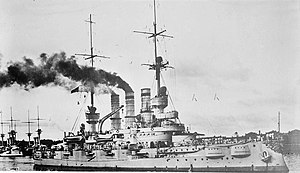
Back SMS Schlesien Czech Schlesien (Schiff) German SMS Schlesien Spanish اساماس شلیزین Persian SMS Schlesien Finnish SMS Schlesien French שלזיין (אוניית מערכה, 1906) HE SMS Schlesien Hungarian SMS Schlesien Italian シュレジェン (戦艦) Japanese
 Schlesien before World War I
| |
| History | |
|---|---|
| Name | Schlesien |
| Namesake | Schlesien |
| Ordered | 11 June 1904 |
| Builder | Schichau, Danzig |
| Laid down | 19 November 1904 |
| Launched | 28 May 1906 |
| Commissioned | 5 May 1908 |
| Out of service | 1 December 1918 |
| Reinstated | 1 March 1927 |
| Fate | Mined off Swinemünde in 3 May 1945, scrapped 1949–1956 |
| General characteristics | |
| Class and type | Deutschland-class battleship |
| Displacement | |
| Length | 127.60 m (418 ft 8 in) |
| Beam | 22.20 m (72 ft 10 in) |
| Draft | 7.70 m (25 ft 3 in) |
| Installed power |
|
| Propulsion |
|
| Speed | 18.5 knots (34.3 km/h; 21.3 mph) |
| Range | 4,770 nmi (8,830 km; 5,490 mi) at 10 knots (19 km/h; 12 mph) |
| Complement | 743 |
| Armament |
|
| Armor |
|
SMS Schlesien[a] was one of five Deutschland-class pre-dreadnought battleships built for the German Kaiserliche Marine (Imperial Navy) between 1904 and 1906. Named after the German province of Silesia, Schlesien was laid down at the Schichau-Werke shipyard in Danzig on 19 November 1904, launched on 28 May 1906, and commissioned on 5 May 1908. She was armed with a battery of four 28 cm (11 in) guns and had a top speed of 18 knots (33 km/h; 21 mph). The ships of her class were already outdated by the time they entered service, as they were inferior in size, armor, firepower, and speed to the revolutionary new British battleship HMS Dreadnought.
After commissioning, Schlesien was assigned to I Battle Squadron of the High Seas Fleet, later being transferred to II Battle Squadron. She was primarily occupied with training cruises and fleet maneuvers in her early career. She served with the fleet throughout the first two years of World War I, seeing action at the Battle of Jutland on 31 May – 1 June 1916, where she was briefly actively engaged in combat. After Jutland, the Imperial Navy relegated Schlesien to guard duties before withdrawing her altogether in 1917, when she became a training ship. The Treaty of Versailles permitted the German navy to keep eight obsolete battleships, including Schlesien, to defend the German coast. Initially kept in reserve, she was modernized in the mid-1920s and saw extensive service with the reorganized Reichsmarine.
Schlesien saw limited combat during World War II, briefly bombarding Polish forces during the invasion of Poland in September 1939. She escorted minesweepers during Operation Weserübung, the invasion of Norway and Denmark in April 1940. After the operation, she was given secondary duties, primarily serving as a training ship and icebreaker. She ended her career providing fire support in the Baltic coast. While off Swinemünde on 3 May 1945, she struck a mine and was towed into Swinemünde, where she was sunk by her crew in shallow water, though much of her superstructure, including her main battery, remained above water. In the remaining days of the war, Schlesien used her anti-aircraft guns to defend the city from air attack. After the end of the war, she was broken up, though some parts of the ship remained visible until the 1970s.
Cite error: There are <ref group=lower-alpha> tags or {{efn}} templates on this page, but the references will not show without a {{reflist|group=lower-alpha}} template or {{notelist}} template (see the help page).